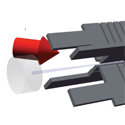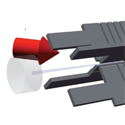Cooling with a cavity
The fine control of trapped ion systems is the basis for a number of practical applications, such as precision spectroscopy, atomic clocks, and quantum computation. One aim is to suppress excess motion of the ion without destroying the coherence of its internal states where, for example, quantum information is stored. Doppler cooling and sympathetic cooling are long-standing methods for reducing the quantum number of the motional states of an ion or neutral atom. Adding to this tool chest of methods is desirable, as the limitations of one method can often be overcome by the other.
Cavity cooling, where the cavity alters the emission spectrum of the particle from that which occurs without the cavity, is a technique that has been successful for cooling neutral atoms and could be extended to cooling ions as well as large molecules. Now, David Leibrandt and colleagues at the Massachusetts Institute of Technology in the US demonstrate, in Physical Review Letters, cavity cooling of a single positively charged ion, . The ion is held in a linear radio-frequency Paul trap, and then cooled in the horizontal direction by a cavity cooling laser. If more energy is, on average, scattered into the cavity than injected by the incident laser, conservation of energy implies that the particle will cool down.
The group measured the cavity heating and cooling rates for the trapped ion and found the steady-state limit of their system to be 22.5 motional quanta. The measurements agree with a theoretical model that predicts ions can be cooled to the ground state, while preserving their internal coherence.
Their results open the possibility to apply cavity cooling to complex quantum systems, such as molecular ions, where other cooling methods fall short. – Sonja Grondalski





